

Clash of Cultures Homepage. WOMENS MAGAZINES OF THE 1920`s 1930`s, 1940`s, role of women, women in society. OF THE 1920's, 1930's, and the 1940's another "content over style" web page from Steve Johnson Cyberheritage or "how to " with cherries and custard!

Or all about constipation and hot flushes! E-mail Steve. Modern Sexuality. Christina Simmons Excerpts: pages 17-20 For twentieth-century Americans the first sexual revolution popularized the image of the flapper, an ideal of youth, beauty, and freedom of action for women, but also one of sexual vitality.

"The emancipated flapper is just plain female under her paint and outside her cocktails," explains a flapper's father in Gertrude Atherton's best-selling novel of 1923, Black Oxen. "More so for she's more stimulated. Where girls used to be merely romantic, she's romantic. . .plus sex instinct rampant. " This group of thinkers created what I call the myth of Victorian repression to describe and condemn old patterns of sexual behavior and shape new ones. These sexual revisionists proclaimed a modernist liberation from a repressive Victorian past, and subsequent historiography has tended to accept that frame of reference.
Women had been key figures in the Victorian ideology of sexual control. Lois Long - Vassar College Encyclopedia - Vassar College. Zelda Sayre Fitzgerald. Beautiful and Damned: Zelda Sayre Fitzgerald by Flapperjane Copyright 2004 by Sarah Baker.
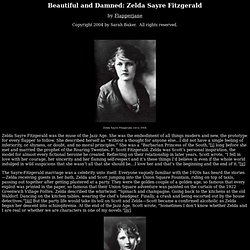
All rights reserved. Zelda Sayre Fitzgerald, circa 1918. Jazz Age Slang. Below you will find an alphabetical listing of slang words used in the "Jazz Age" (generally taken to mean the years of the Roaring Twenties and the Great Depression).

The Jazz Age was the first modern era to emphasize youth culture over the tastes of the older generations; the flapper sub-culture had a tremendous influence on main stream America--many new words and phrases were coined by these liberated women. These are the most common words and phrases of the time, many of which you may be surprised to note are still very much in use today! Some entries were the exclusive domain of students (or rather, those of student age; only a very small percentage of the population attended college) or flappers and have been indicated as such with italicized monikers.
Also, the words that emerged in a particular year are noted appropriately. Temperance & Prohibition. Al Capone: Chicago's Most Infamous Mob Boss — Made In America. Al Capone's mugshot, with his fedora hat Quite a lot has been written and said about Al Capone in newspaper and magazine articles, books, and movies that is completely false.
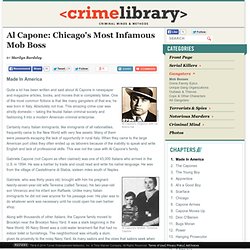
Gapers Block: Airbags - The Untouchable Eliot Ness. "When they were settled, and while the newsreels were setting up their cameras, I told them of the attempted briberies.
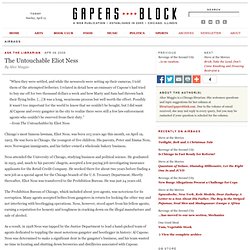
I related in detail how an emissary of Capone's had tried to buy me off for two thousand dollars a week and how Marty and Sam had thrown back their flying bribe. [...] It was a long, wearisome process but well worth the effort. Possibly it wasn't too important for the world to know that we couldn't be bought, but I did want Al Capone and every gangster in the city to realize there were still a few law enforcement agents who couldn't be swerved from their duty. " Prohibition: The Noble Experiment. So convinced were they that alcohol was the cause of virtually all crime that, on the eve of Prohibition, some towns actually sold their jails. 1 During the early 1800's, temperance societies offered two pledge options: moderation in drinking or total abstinence.
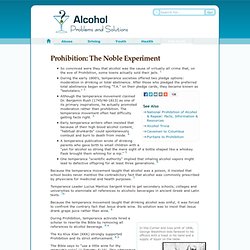
After those who pledged the preferred total abstinence began writing "T.A. " on their pledge cards, they became known as "teetotalers. " 2 Although the temperance movement claimed Dr. Benjamin Rush (1745/46-1813) as one of its primary inspirations, he actually promoted moderation rather than prohibition. Because the temperance movement taught that alcohol was a poison, it insisted that school books never mention the contradictory fact that alcohol was commonly prescribed by physicians for medicinal and health purposes. 7 Temperance Leader Lucius Manlius Sargent tried to get secondary schools, colleges and universities to eleminate all references to alcoholic beverages in ancient Greek and Latin texts. 7a.
The Free Online Encyclopedia of Washington State History. HistoryLink.org Essay 5534 : Printer-Friendly Format Dance Marathons (also called Walkathons), an American phenomenon of the 1920s and 1930s, were human endurance contests in which couples danced almost non-stop for hundreds of hours (as long as a month or two), competing for prize money.
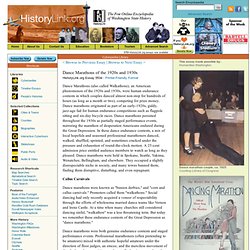
Dance marathons originated as part of an early-1920s, giddy, jazz-age fad for human endurance competitions such as flagpole sitting and six-day bicycle races. Dance marathons persisted throughout the 1930s as partially staged performance events, mirroring the marathon of desperation Americans endured during the Great Depression. The 1920's. LABORERS IN THE VINEYARD should welcome, and do, the good news from the Vatican that the jazz age is passing, and that the flood of immorality which lapped every shore is receding.
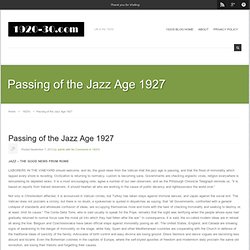
Civilization is returning to normalcy, custom is becoming sane, Governments are checking orgiastic vices, religion everywhere is remustering its depleted ranks. It is a most encouraging note, agree a number of our own observers, and as the Pittsburgh Chronicle Telegraph reminds us, “it is based on reports from trained observers. It should hearten all who are working in the cause of public decency and righteousness the world over.” Not only is Christendom affected, it is announced in Vatican circles; but Turkey has taken steps against immoral dances, and Japan against the social evil.
1920's Car Advertisements. Color Photography in Car Advertising.
